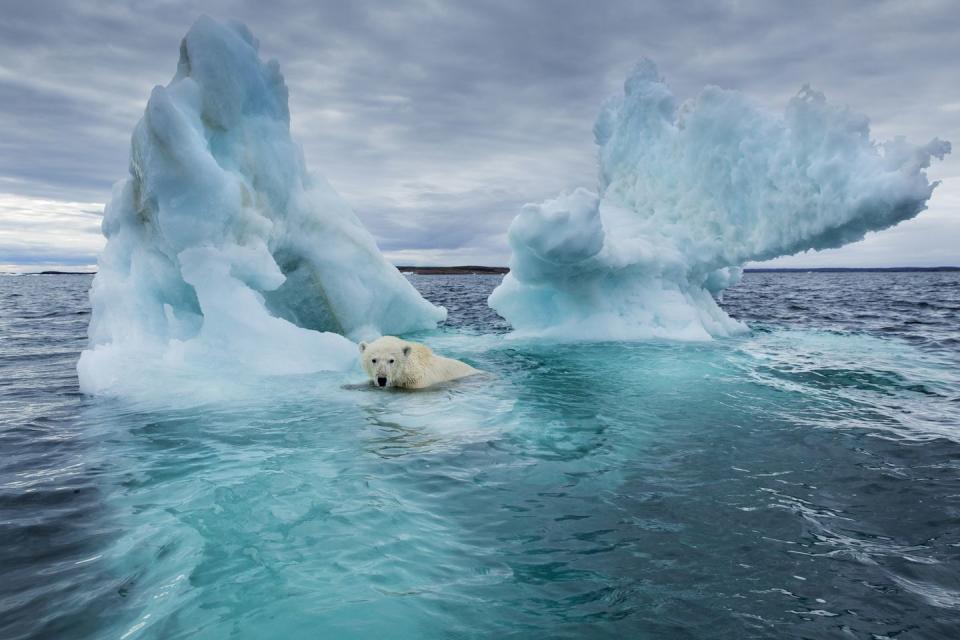Here’s One Way We Could Refreeze Earth’s Melting Polar Ice

Scientists believe tanker planes could spray sulfur dioxide aerosol in the upper atmosphere over Earth’s poles to help them refreeze.
The temperatures of Earth’s poles could be cooled by about 2 degrees Celsius, the study says, costing about $11 billion annually.
But this proposal comes with risks, and it’s not a final solution to climate change—just a Band-Aid.
Faced with the growing threat of a warming world, scientists continue to concoct new concepts for stabilizing Earth’s temperatures. The latest entrant is a plan published in Environmental Research Communications that calls for high-altitude tanker planes to spray aerosol particles over Earth’s subpolar regions. Once in place, they would help deflect incoming solar radiation.
🌏 You want to keep up with the latest Earth news. Learn with us—join Pop Mech Pro.
These stratospheric aerosol injections (SAI), as the study calls them, offer “a prospective climate intervention that would seek to abate global warming by slightly increasing the reflectiveness of the Earth’s upper atmosphere.”
The concept of SAI is nothing new, but this proposal calls for aerosols to be targeted at the places where melting ice can most dramatically lead to sea-level rise across the entire planet. With greater warming at the Earth’s poles over time, the study calls for “injections of sulfur dioxide (SO2)... which will oxidize into sulfuric acid (H2SO4) and coagulate into liquid supercooled aerosols after a month in the stratosphere.”
The expectation is that this could lower temperatures at the poles by 2 degrees Celsius. That’s enough cooling to help refreeze the polar extremes and bring average temperatures back in line with what they were before the industrial era. The harmful effects of climate change, such as extreme weather and massive flooding, could possibly be slowed.
“Subpolar deployment would quickly envelope the poles as well and could arrest or reverse ice and permafrost melt at high latitudes. This would yield global benefit by retarding sea level rise,” writes lead author Wake Smith in the study. Smith is a lecturer at Yale College and senior fellow at the Harvard Kennedy School. Unlike previous aerosol plans, which would encompass the entire Earth, the one Smith proposes focuses just on latitudes beyond 60 degrees north and south (think north of Anchorage, Alaska, and south of Patagonia).
“Because the tropopause is considerably lower at high latitudes, aerosols or their precursors would not need to be lofted as high, reducing the engineering challenges relative to a global deployment,” Smith writes.
In order to work, the study determined the aerosol would need to be released at a minimum altitude of 13 kilometers, or 43,000 feet above Earth’s surface—a lower altitude than required elsewhere in the world by other SAI plans. To offset the greatest amount of solar radiation, a specialized fleet of around 125 aircraft would work during the extra-long spring and early summer days of one hemisphere before traveling to the other pole to perform the same tasks.
There’s just one hitch: releasing the necessary payload of aerosol at that altitude is beyond the capability of any current tanker aircraft. The researchers narrowed the potential aircraft down to the Boeing KC-135R, the Boeing KC-46A Pegasus, the Airbus A330 MRTT, the Boeing KC-10, and the Airbus A340F—but all would still need to be modified for the mission. Ideally, a purpose-built “lofter” plane designed by the researchers would be used, called the SAIL-43K, which is based on the SAIL-01 design.
By focusing effort on the poles, the plan would reduce costs radically over other SAI plans, according to the study, with an annual price tag of just $11 billion. That’s significantly less than the projected annual cost of $36 billion to lower the surface temperature by the same degree over the entire Earth instead.
Of course, a less generous disbursement of aerosol also helps with the obvious concerns about dumping particles into the atmosphere. Will the aerosols have an unexpected ecological impact on Earth, if the delivery could lead to further depletion of the ozone? “There is widespread and sensible trepidation about deploying aerosols to cool the planet,” Smith says, “but if the risk-benefit equation were to pay off anywhere, it would be at the poles.” This plan would decrease the risks, with less than one percent of the human population living within those areas.

The concept of stratospheric aerosol injections comes with a host of unknowns. Along with devising the best aerosol to use—the most recent study sticks with a commonly considered sulfur-based aerosols—scientists aren’t certain of the best delivery method or how long the aerosols will provide benefit once released. Could we eventually see giant SO2 rockets that release aerosols over other continents to slow down global warming, like in the futuristic geoengineering-themed novel Termination Shock by Neil Stephenson? Maybe not, but this could be the first step.
Plus, this SAI proposal is by no means the ultimate solution to climate change. “Game changing though this could be in a rapidly warming world, stratospheric aerosol injections merely treat a symptom of climate change but not the underlying disease,” Smith says. “It’s aspirin, not penicillin. It’s not a substitute for decarbonization.”
While it’s still preliminary in concept, the study authors believe the idea warrants exploration. “Given its apparent feasibility and low cost,” they write, “this scenario deserves further attention.”
You Might Also Like

